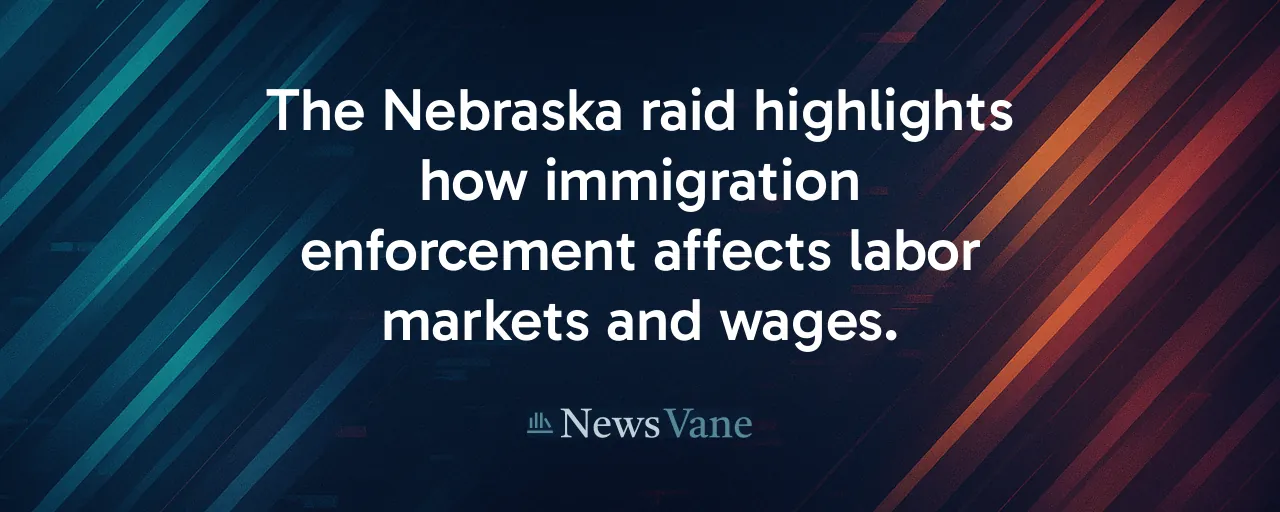A Nebraska Raid Reignites Old Tensions
In June 2025, federal agents swept into a Nebraska meat-processing plant, detaining over 70 undocumented workers. The raid, one of the largest under President Trump's second term, left the facility scrambling to fill half its workforce. Local residents stepped in, applying for jobs once held by immigrants. The episode, spotlighted by Sen. Eric Schmitt on national television, has reignited a fierce debate about who should fill America's low-wage jobs.
The Omaha case serves as a flashpoint in a decades-long argument about immigration, labor markets, and economic fairness. Some see the raids as a victory for American workers, proving citizens will take tough jobs if given the chance. Others warn that removing immigrant labor disrupts industries and drives up costs for everyone. The truth lies in a tangle of economic data, human stories, and policy choices.
This discussion dives into the issue, exploring how workplace enforcement shapes jobs, wages, and communities. It examines evidence from both sides, draws on historical patterns, and considers practical solutions that prioritize economic stability and fairness for all workers.
The Labor Puzzle: Who Fills the Gaps?
Undocumented workers make up about 4 to 5 percent of the U.S. labor force, but their presence is far larger in specific industries. In meatpacking, crop agriculture, and construction, they account for over 15 percent of workers. These jobs are grueling, often low-paying, and located in rural areas where local labor is scarce. The Nebraska raid exposed a core question: can American workers realistically fill these roles?
Sen. Schmitt argues yes, pointing to Omaha, where locals applied after the raid. Studies from groups like the Center for Immigration Studies back this, showing that tight labor markets can draw native workers to manual jobs when wages rise. Historical enforcement surges, like the 2006 Swift & Co. raids, saw similar upticks in native hiring. Yet, other data complicates the picture. Peer-reviewed studies find that removing undocumented workers often leads to higher turnover and lower industry wages, as employers struggle to recruit and retain locals.
Beyond willingness, many low-wage jobs require workers to relocate to remote areas, often without affordable housing or childcare. In Omaha, new hires faced long commutes and inconsistent schedules, hurdles that deter long-term commitment. Automation could help, but it demands time and capital that many employers lack.
Wages, Costs, and Economic Ripples
A central issue in the debate is wages. Some argue undocumented workers depress pay, keeping jobs unattractive to citizens. Research from the Center for Immigration Studies links high immigration to lower labor-force participation among less-educated men. In contrast, economists at the Economic Policy Institute find that mass deportations can harm native workers by shrinking local economies, estimating that each million deportations may push 88,000 citizens out of work.
Consumers feel the impact too. Raids like Omaha's disrupt production, leading to food price spikes. After similar raids in 2019 Mississippi poultry plants, local grocery costs rose as supply chains faltered. On the flip side, legalizing undocumented workers could boost payroll taxes and consumer spending, potentially stabilizing prices. The catch? Enforcement operations cost billions, straining public budgets without clear long-term gains.
Communities also bear the cost. Raids destabilize families, spark fear among legal immigrants, and strain local services. Yet, if wages rise enough, some towns could see revitalized job markets, attracting workers to industries long reliant on immigrant labor.
Lessons From the Past
History offers context for today's debate. The 1942-64 Bracero Program brought millions of Mexican workers to U.S. farms, filling labor gaps during wartime. When it ended, employers struggled, and some crops went unharvested. The 1986 Immigration Reform and Control Act legalized millions but failed to curb illegal hiring due to weak enforcement. More recent raids, like those in 2006 and 2019, showed that enforcement alone doesn't solve labor shortages; it often shifts the burden to communities and consumers.
These patterns suggest a disconnect. The current visa system doesn't match industry needs, leaving employers dependent on undocumented labor. Abrupt deportations create short-term chaos, while ignoring illegal hiring undermines labor standards. Economists argue that without legal pathways or automation, industries like meatpacking will continue to cycle through crises.
Bridging the Divide
Finding common ground requires balancing economic realities with legal priorities. One option is phased mandatory E-Verify, paired with guest-worker visas tailored to industries like agriculture and meatpacking. This could reduce illegal hiring while ensuring a steady labor supply. Another approach is legal status for long-time workers in essential sectors, coupled with stricter fines for future violations, preserving community stability and deterring exploitation.
Investing in American workers is also key. Wage subsidies, training programs, and tax credits could make low-wage jobs more appealing. Federal and state funds could support housing and childcare in rural areas, easing barriers for new hires. Automation, while costly, offers a long-term fix, reducing reliance on any single labor pool.
Stronger labor standards could protect all workers, citizen or immigrant. Independent enforcement of wage and safety rules would curb exploitation, ensuring fair competition. These steps, grounded in data and past experience, aim to stabilize industries without pitting workers against each other.
Looking Ahead
The Nebraska raid and its fallout underscore a complex truth: America's labor market is deeply intertwined with immigration. Enforcement alone cannot resolve the tension, and ignoring illegal hiring undermines labor standards. The debate calls for solutions that respect workers, stabilize industries, and protect communities.
Evidence points to a multi-pronged approach: legal pathways for essential workers, incentives for citizens to fill gaps, and investments in automation to ease labor shortages. These steps could reduce economic disruptions while upholding labor standards. The Omaha case, while a single snapshot, highlights the stakes for workers, employers, and consumers alike.
As policymakers grapple with these issues, the focus needs to remain on practical outcomes. Jobs, wages, and prices affect every American, regardless of where they stand on immigration. By addressing root causes, from visa mismatches to wage gaps, the nation can move toward a labor market that works for everyone.
